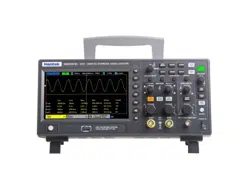Loading ...
Loading ...
Loading ...

User Manual
19 / 68
2. Press the Source 1 and Source 2 softkey respectively, and turn the Multifunctional Knob to select the source to do math
operation. Analog channels (CH1~CH2) can all be used as Source 1 or source 2.
3. Press the Operator softkey and turn the universal to select + or -to make addition or subtraction operation. The resulting
math waveform is displayed on the screen and labeled with “M”.
4. Press the Scale softkey, and turn the Multifunctional Knob to select the vertical scale.
5. Press the Offset softkey, and turn the Multifunctional Knob to set offset.
Multiplication and Division
Math operators perform arithmetic operations multiplication or division operation on any two analog input channels. When you
select multiplication or division, the Source 1 and Source 2 values are multiplied or divided point by point and the result is
displayed.
1. Press the [Math] button on the front panel to enter the MATH function menu.
2. Press the Source 1 and Source 2 softkey respectively, and turn the Multifunctional Knob to select the source to do math
operation. Analog channels (CH1 ~CH2) can all be used as Source 1 or source 2.
3. Press the Operator softkey and turn the universal to select * or / to make multiplication or division operation. The resulting
math waveform is displayed on the screen and labeled with “M”.
4. Press the Scale softkey, and turn the Multifunctional Knob to select the vertical scale.
5. Press the Offset softkey, and turn the Multifunctional Knob to set offset.
FFT Operation
FFT is used to compute the fast Fourier transform using analog input channels or reference waveform. FFT takes the digitized
time record of the specified source and transforms it to the frequency domain. When the FFT function is selected, the FFT
spectrum is plotted on the oscilloscope display as magnitude in dBV versus frequency. The readout for the horizontal axis
changes from time to frequency (Hertz) and the vertical readout changes from volts to dB. The mathematical calculation
function can convert the 2048 center points of the time domain waveform into an FFT spectrum. The final FFT spectrum
contains 1024 points from DC (0 Hz) to the Nyquist frequency. Normally, the display screen compresses the FFT spectrum
horizontally to 250 points, but you can use "FFT zoom" to expand the FFT spectrum to more clearly see the frequency
components of each of the 1024 data points in the FFT spectrum. FFT operation can facilitate the following works:
Loading ...
Loading ...
Loading ...
